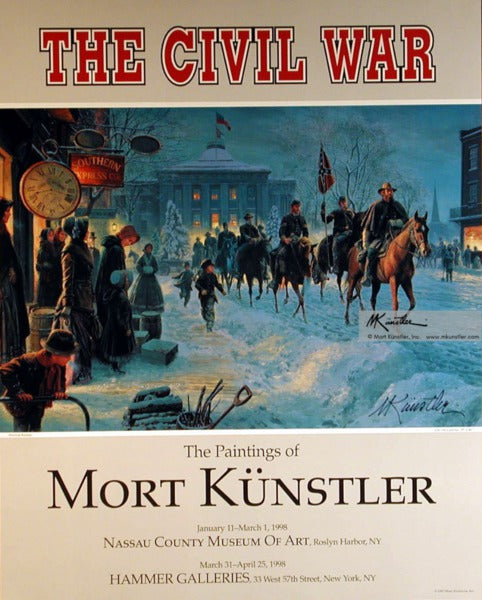The Official Mort Künstler Website
Winter Riders – Poster
Winter Riders – Poster
Raleigh, North Carolina, February 5, 1863
Couldn't load pickup availability
This poster is from the 1998 traveling exhibit entitled The Paintings of Mort Künstler. The exhibits were at the Nassau County Museum of Art, in Roslyn, New York and Hammer Galleries, in New York.
Historical Information
They had gone to war reluctantly, but no Confederates had done more to defend the South than the citizens and soldiers of North Carolina. They had cautiously waited, watching with sadness and sympathy, as one Southern state after another seceded from the Union. Even after warfare erupted at Fort Sumter, many North Carolinians hoped negotiations would hold the Union together. Not until President Lincoln called for 75,000 Northern volunteers to invade the South, did the citizens of “the old North State” vote to secede. They would not allow Northern troops to cross their borders for the purpose of making war on fellow Southerners.
By early 1863, as gray-clad North Carolina troops tramped down Raleigh's snow-covered streets, the Tar Heels had proven they were not reluctant warriors. They had fought and died in significant numbers in every theater of the war east of the Mississippi. Although North Carolina contained one-ninth of the Confederate population, one-sixth of Southern troops were North Carolinians. Tar Heel civilians were also doing their part for “the Cause,” providing rations, equipment and arms from Carolina fields, factories and blockage runners.
What thoughts were in the minds of Raleigh’s women and children as they watched the men of their state heading through a snowy night, bound for faraway warfare and an uncertain future? What images preoccupied North Carolina’s young Confederate warriors as they passed Raleigh’s warm and beckoning lights? Would they return to home and family? Would they fall on a distant battlefield, slain by a foe they had ever met?
In February of 1863, what lay ahead for many North Carolina soldiers and thousands of other Southern troops was the greatest battle of the war – the greatest battle ever fought in North America – looming in the summer to come at an obscure Pennsylvania hamlet called Gettysburg. There, thousands of Tar Hell troops would lay down their lives in defense of homes and homeland at peaceful-sounding sites like McPherson's Ridge, Willoughby’s Run and Cemetery Ridge. Of the 15,000 Confederates killed and wounded at the battle of Gettysburg, one-fourth would be from North Carolina.
There, noted a surviving Tar Heel, and on countless other bloody fields of fire, the Confederates from North Carolina “covered themselves with glory.”
Mort Künstler’s Comments
I love painting snow scenes and night scenes, so working on Winter Riders was a delight for me. The painting originated in 1992 with an invitation from the North Carolina Museum of History in Raleigh. The museum staff asked me to host a one-man exhibition of my Civil War art.
I was honored by the invitation and wanted to do a unique painting that symbolized North Carolina’s important role in the War Between the States. Choosing an appropriate subject was difficult. I had already painted the state’s most famous engagement – the Battle of Fort Fisher – in The Gunner and the Colonel and I had also painted the heroic charge of the 26th North Carolina at Gettysburg in The High Water Mark.
Finally, after two years and several visits to Raleigh, the concept for Winter Riders emerged. Featuring Confederate troops and civilians, it represents North Carolina’s major contribution to the war: its people. It also allowed me to focus on a snow scene and a night theme set near the North Carolina Capitol – appropriately near the the modern site of the new museum.
With the help of Raymond Beck, the Capitol historian, I learned what shops were located on Fayetteville Street during the war, which added color as well as authenticity to the painting. The owner of the jewelry store, for instance, was a Raleigh silversmith named John C. Palmer, whose handiwork is now part of the Museum‘s collection. The Capitol and Christ Episcopal Church have changed little in appearance since the war and today look virtually the same as they did in 1863. In front of the south facade of the Capitol is sculptor Jean Houdon‘s statue of George Washington, which still stands in the same spot today. The iron fence glimpsed just to the left of the horse and wagon encircled the Capitol in the 1860s and today can be seen surrounding Raleigh’s City Cemetery. I learned that the capital was blanketed with snow on February 5, 1863, so that was the date I picked to paint this scene.
The State Museum’s military curator: Tom Belton, provided research on uniforms, equipment, and accoutrements. the painting reflects the careful research of knowledgeable North Carolina historians, even the location of the street lamps and the lighting in the Capitol windows are accurate.
Flying atop the Capitol dome is the Confederacy’s First National Flag and the North Carolina State Flag. The Confederate battle flag carried by North Carolina Cavalry gave me the opportunity to show all three flags in the same painting.
After all the work was done and Winter Riders was finished, I was pleased with the final result - and I hope the viewer is too.
Note: This poster is unsigned.





